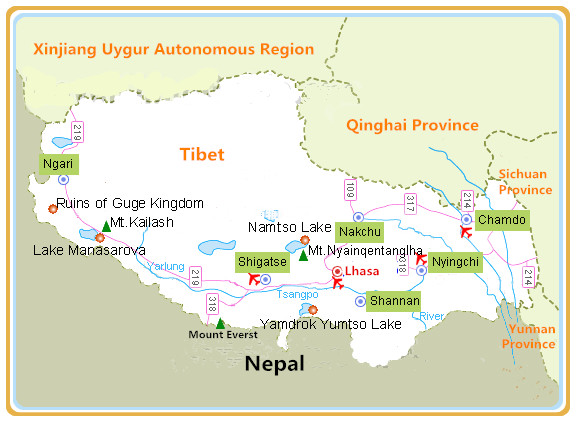Skype: neodalle-travel
Tel: +86 135 7447 2266
E-mail: sales@visitaroundchina.com
 Lhasa is a holy city and capital of China's Tibet Autonomous Region. situated at the roof of the world, Lhasa City is known as " the city of sunshine" and " the land of Gods". Located at an altitude of 3658 meters and at the bottom of a small basin surrounded by mountains and rivers, Lhasa has a mild climate, without extremely cold winter and severely hot summer. Therefore, throughout the year for Lhasa are quite suitable for travelling. Travelers can travel to Lhasa by train and by air.All pervaded sacred religious atmosphere mixed with leisure, happiness and the smell of sunshine, Lhasa has been the destination of travel the beginning of lives for many people.
Lhasa is a holy city and capital of China's Tibet Autonomous Region. situated at the roof of the world, Lhasa City is known as " the city of sunshine" and " the land of Gods". Located at an altitude of 3658 meters and at the bottom of a small basin surrounded by mountains and rivers, Lhasa has a mild climate, without extremely cold winter and severely hot summer. Therefore, throughout the year for Lhasa are quite suitable for travelling. Travelers can travel to Lhasa by train and by air.All pervaded sacred religious atmosphere mixed with leisure, happiness and the smell of sunshine, Lhasa has been the destination of travel the beginning of lives for many people.History of Lhasa
Honored with a long history of 1300 years, Lhasa is quite rich in unique cultural and spiritual resources, especially its Buddhism culture. Today, numerous cultural relics and historic sites covered with thick religious color remain in Lhasa. The attractions of Lhasa do not only lie in its cultural and historic sites, but also in its breathtaking natural scenery.
When to visit Lhasa?
By Train: Taking the train, is a fabulous new option, giving the opportunity to see hitherto unseen mountain scenery. With the operation of Tibet Railway from July 1st, 2006, more and more visitors have swarmed into the land via train. Lhasa Railway Station has only one railway, also known as legendary Tin Road - Qinghai - Tibet Railway. It stops along the way Golmud, Xining, Lanzhou, Xi'an, Zhengzhou and other sites. The railway can reach Beijing, Guangzhou, Chengdu, Shanghai,Chongqing,Wuhan,Changsha and other places. Lhasa railway station is located in the southwest of Lhasa, about 8 km from the city center.
By Bus:Taking the bus along one of five highways that have been opened-up for visitors' use. This will take longer but will enable you to see the amazing scenery en route. Furthermore, taking extra time allows for a more gradual acclimatization to the altitude.
Lhasa Travel Tips
Shopping in Lhasa: Tibet has many arts and crafts products full of local flavor and national style, all kinds of Tibetan traditional handicraft products such as wooden bowl, bamboo bowl; and also imitations made in batch processing by Nepal, India and other countries businessman, such as various kinds of bone carving animals. Tourists can buy a lot of goods in Tibet, the famous are like Thangka, Tibetan knife, Tibetan mask, as well as Tibetan medicine and tonic, cordyceps sinensis, saffron, tricholoma matsutake, and so on.
Lhasa Tourism: There are many archaeological sites in Lhasa, Potala Palace, Jokhang Temple and Norbulingka is listed as world cultural heritage. The main tourist attractions are Drepung Monastery, Sera Monastery and Ramoche Monastery, etc. The main commercial districts are Barkor Street, Yutuo Road and Lhasa Department Store. And there are geothermal hot springs around the land that have economic value and medical treatment, like Duilong Deqing county Qusang hot springs, Maizhokunggar county Dezhong hot springs.
Lhasa Shopping Lhasa Dining Lhasa Nightlife
 Ask Questions ?
Ask Questions ?